Singapore mahjong rules
The game of mahjong needs no introduction – we’ve seen it in classic Hong Kong films, witnessed our grandparents at their weekend marathons, and now plenty of us young’uns have hopped on the bandwagon too. But for those who’re unfamiliar with the game, fret not, as we’re here to help turn you into a mahjong master.
We break down various Singapore mahjong rules and throw in tips on how to earn the biggest bucks. Pay close attention, as this guide will contain all the nitty-gritty details you need to know about the game. Now let’s get this party started.
Table of Contents
Where to buy mahjong sets & tables?
If you do not have a mahjong set and table, it’s worth noting the different types available:
- Foldable mahjong table
- Automatic mahjong table
- Portable mahjong set
- Mahjong card set
The foldable mahjong table is the standard table that most people play mahjong on. It’s typically a 90cm square table that can be kept in your storeroom until CNY comes around. The automatic mahjong table is for those who prefer the tiles to be set up for quicker games. However, it’s quite bulky and heavy, and it would require a permanent place to sit all year round.
The portable mahjong set uses smaller tiles and a smaller table – around 50cm by 50cm. Because of its size, it’s easier to bring around for a game. The most portable version is the mahjong card set, which is small enough to fit in your pocket or bag.You can also opt for mahjong mats or mahjong paper if you want to play it on your dining table without accidentally scratching it.
What are the types of tiles in mahjong?
You must learn to walk before you can fly. In preparation for your first game, you’ll want to familiarise yourself with the different types of tiles in a typical mahjong game.
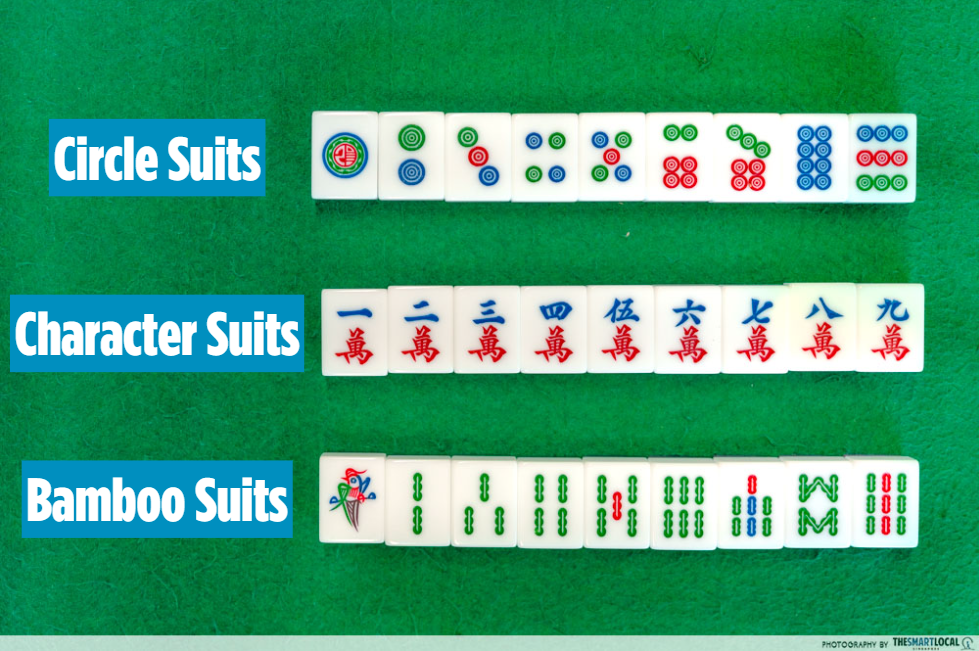
There are a total of 148 tiles, with 3 main suits – Circles, Bamboos, and Characters. Each of these suits runs from numbers 1-9, and there are 4 of each number. While it’s easy to count the Circles and Bamboos suits, do remember the Characters suits for 1-9 if you’re not familiar with Chinese characters. It’s worth noting that the first tile of the Bamboos suits is a bird – not to be confused with the Animal tiles.
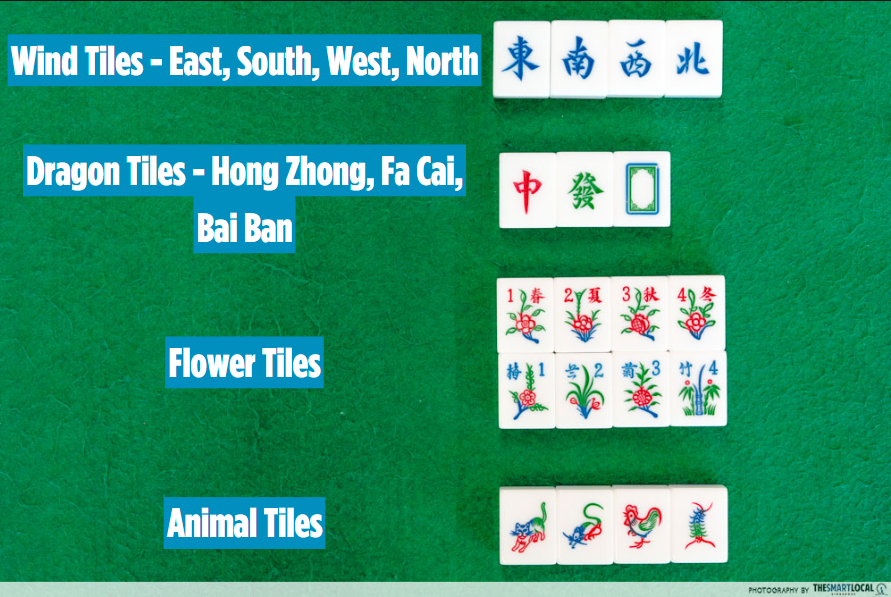
There are also other playing tiles that you can incorporate into your hand. These are the 4 Wind tiles – East, South, West, and North; the 3 Dragon tiles – Hong Zhong, Fa Cai, and Bai Ban. Finally, you have the Flower and Animal tiles. The Flower tiles are numbered from 1-4, while the Animal tiles are a set of a Cat, Rat, Rooster, and Centipede tile. Knowing this would be important to earn money instantly.
How to set up the play sequence?

Whether you’re a Superstitious Sally or someone who believes in the power of their own juju, seating positions can sometimes make or break your game. Just think about it – if you’re sitting next to someone who plays aggressively, chances are you’ll have to take one for the team and block them.
The first player, AKA the dealer, will have first dibs on where they want to sit. There are various ways to decide who the dealer is, depending on the house rules. For example, it can be as simple as whichever player rolls the highest number on the dice. The player who rolls the second-highest number will be the 2nd player, and so on.
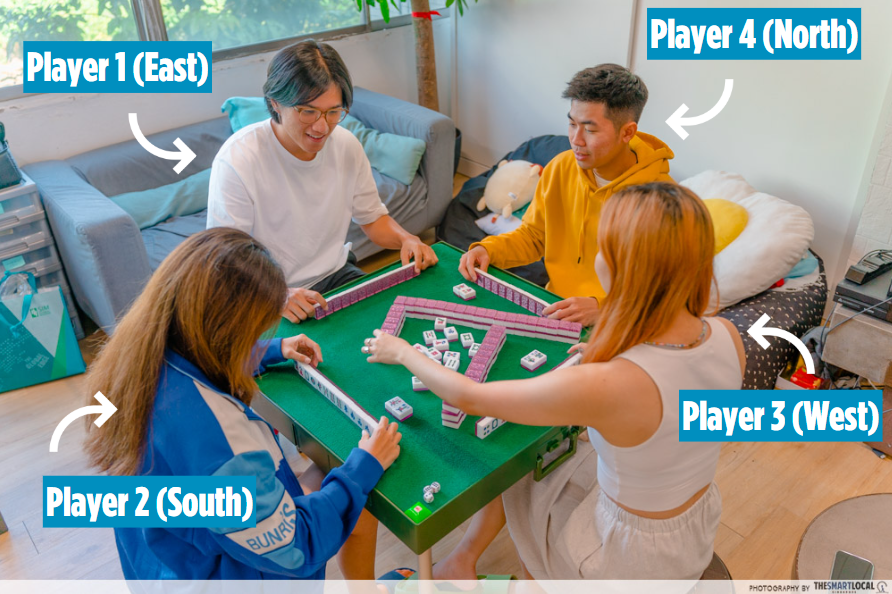
Once the dealer has been established, they can choose their preferred seat. The first player is labelled as number 1 and East, and this will come into play later during the game. Following player 1, the second player (number 2, South) will sit on his/her right. The third player (number 3, West) will sit opposite the dealer, and the last player (number 4, North) will take the final seat.
The dealership doesn’t always stay with one player – it will be passed on to the second player if the dealer loses the round. So if you win every round continually, you can retain your dealer status.
The playing sequence will also follow this order – meaning that once the first player draws and discards a tile, the second player will go next.
What are the Singapore mahjong rules?
Now that the tiles and you are basically one, it’s time to learn how to play mahjong. Different places have their own style of mahjong, and we will be going through the Singapore mahjong rules. While there may be a handful of rules, you’ll come to learn that they are pretty straightforward. And hey, you don’t even need to be fluent in Chinese to understand them.
Starting a game of mahjong
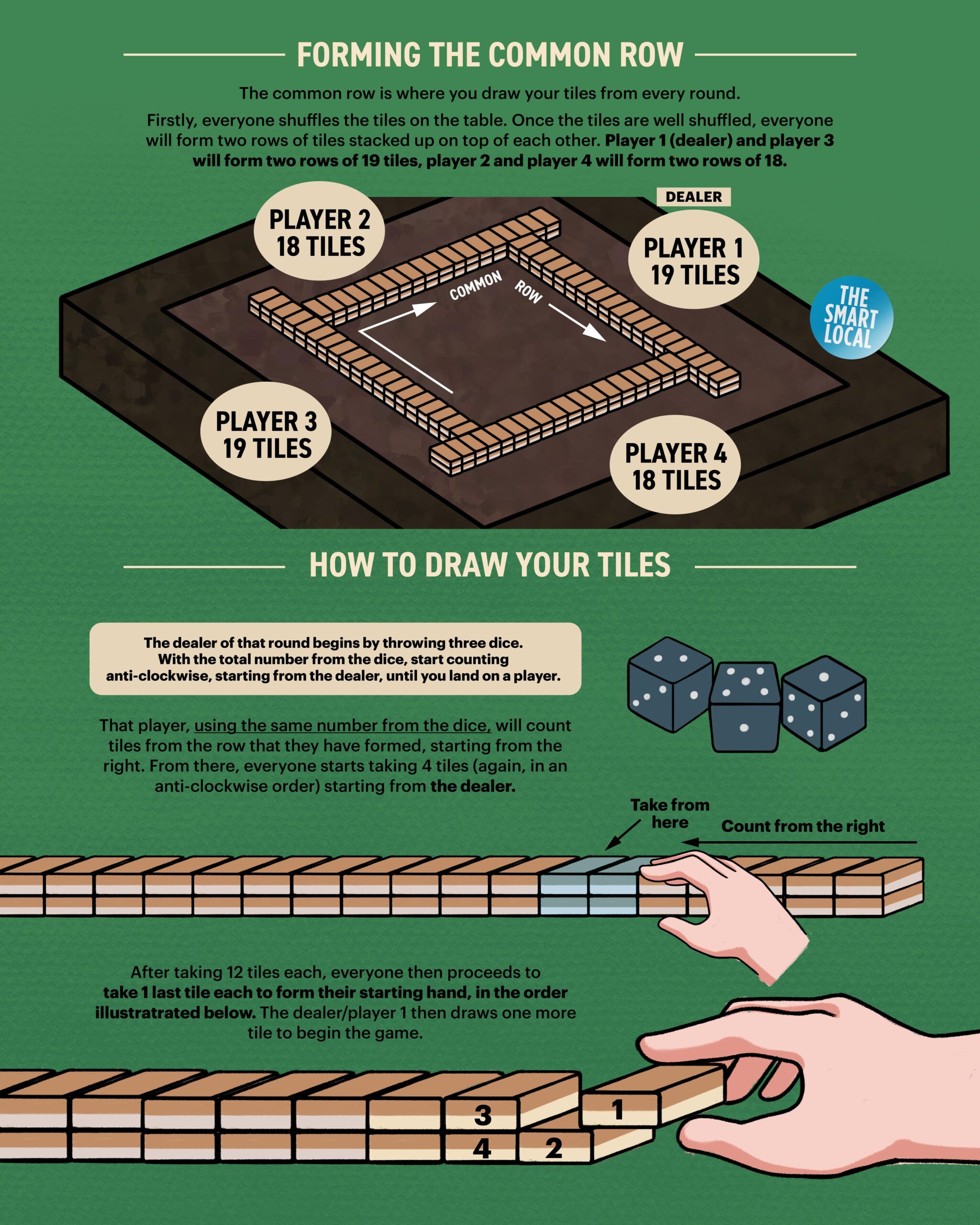
To start each round, players will assemble all the tiles into the communal rows. Players 1 and 3 will build 2 rows of 19 random tiles, while players 2 and 4 will build 2 rows of 18 tiles. The dealer will roll 2 or 3 dice, depending on preference, to decide which common row players will draw their tiles from. Players will take turns drawing 4 tiles each clockwise from the “tail” of the common row, until everyone has 13 tiles on hand. Each player will then draw their last tile, with the dealer drawing an additional 1 after everyone.
Being the dealer comes with its advantages, as they will have 14 tiles at the start. They will start the game by discarding 1 tile, without drawing from the common row. Player 2 will continue by drawing a new tile, then discarding 1 to close his turn. An important thing to remember is that, though the playing sequence is counterclockwise, you draw tiles from the common row clockwise.
Playing a game of mahjong
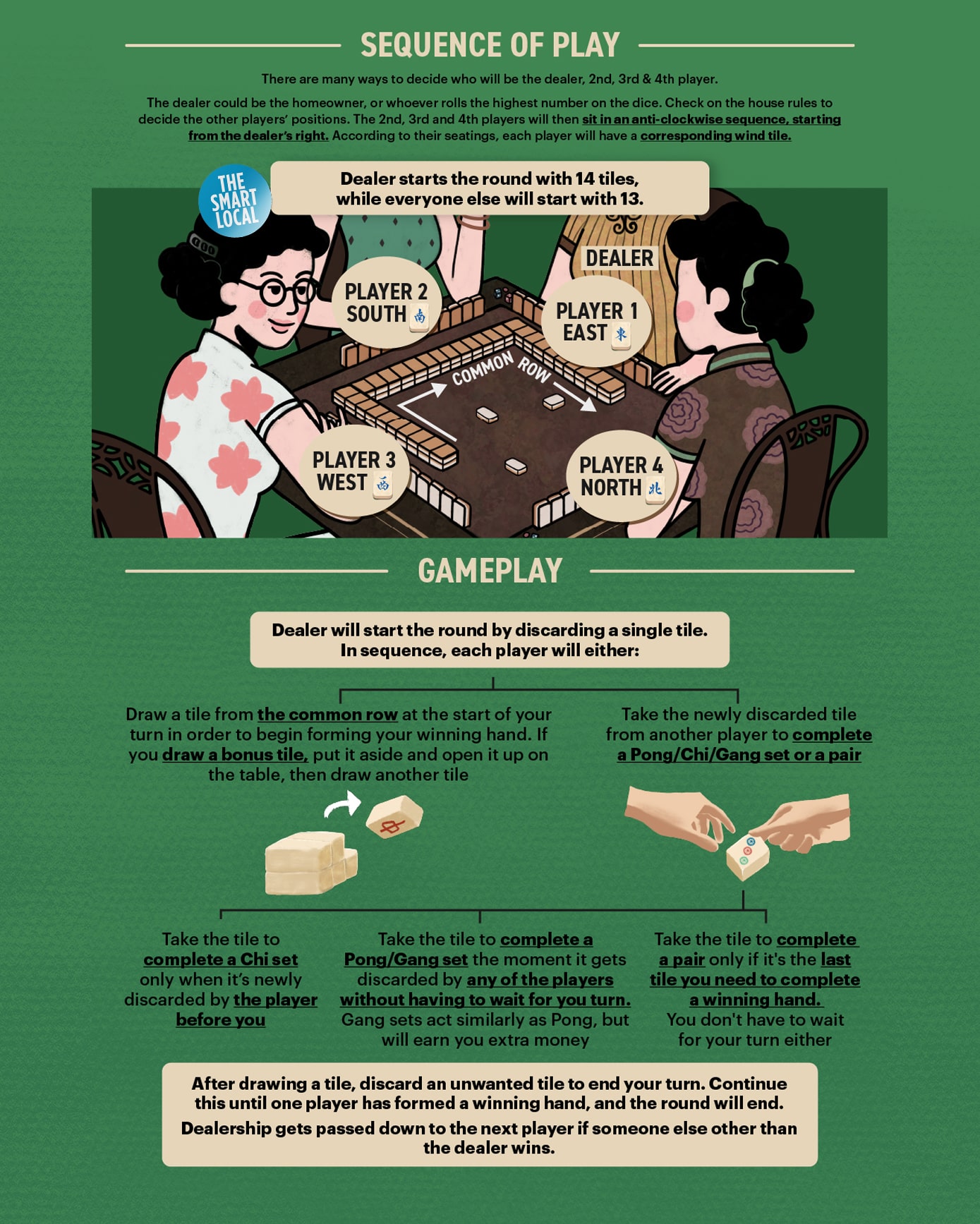
Each player can choose to draw a new tile from the common row or take another player’s discarded tile. And if you draw any Flower or Animal tiles, you will have to display those in your “garden” at the front of your hand, and draw a replacement tile from the “tail” of the common row.

The main objective here is to assemble a winning hand, and the 3 most common combinations you can form in a hand are: chi, where it is a sequence of 3 same-suited tiles; pong, where it is 3 of the same tiles; and gang, where it is 4 of the same tiles.
But forming these combinations is not as easy as it seems. While you have both options of either drawing your preferred tiles from the common row or taking an opponent’s discarded tile, there are exceptions to note. Those forming a chi combination will only be able to take a discarded tile from the player before you. For pong and gang, you are free to take the matching tile from anyone.
If you have taken a tile from another player to complete your combination, you will have to display your finished set in your “garden” as proof. That being said, if you achieve a combination by drawing from the common rows, you are not required to show your set. However, if you have a pong in your “garden”, you cannot upgrade it to a gang if someone discards the tile – you would need to draw it yourself.
How do you win a mahjong game?
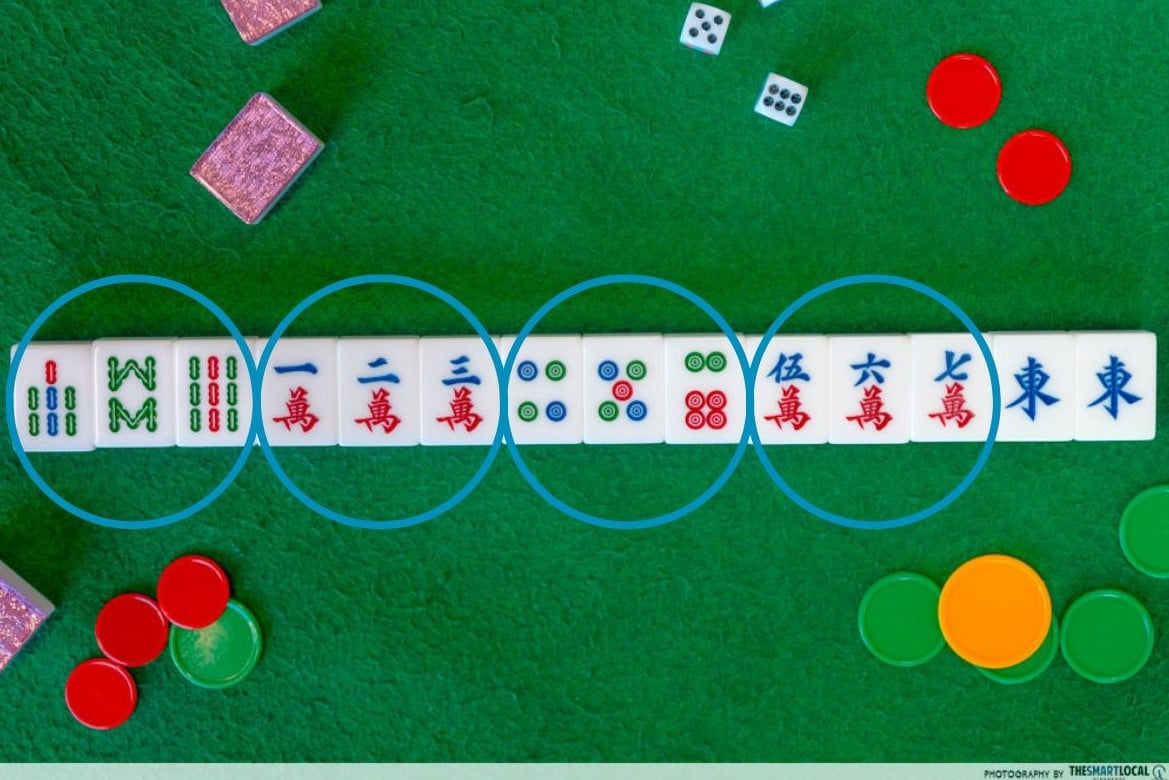
An example of a basic winning hand – 4 sets of completed combinations, and a pair of “eyes”.
We promised lessons on how to win, so here they are. The round ends when a player has put together a winning hand, or if you run out of tiles in the common rows. And the more tais – AKA points – you accumulate, the more money you’ll win.
Different winning combinations
There are plenty of ways to accumulate tais, ranging from the basic Ping Hu to the 13 Wonders you often see on TV. But before we list out the different winning combinations, it’s important to remember that the amount of tais each combination gets is dependent on the respective house rules, so it’s best to clarify and agree on the terms prior to the game.
Now that we’ve gotten that out of the way, here are the common winning combos you can assemble:
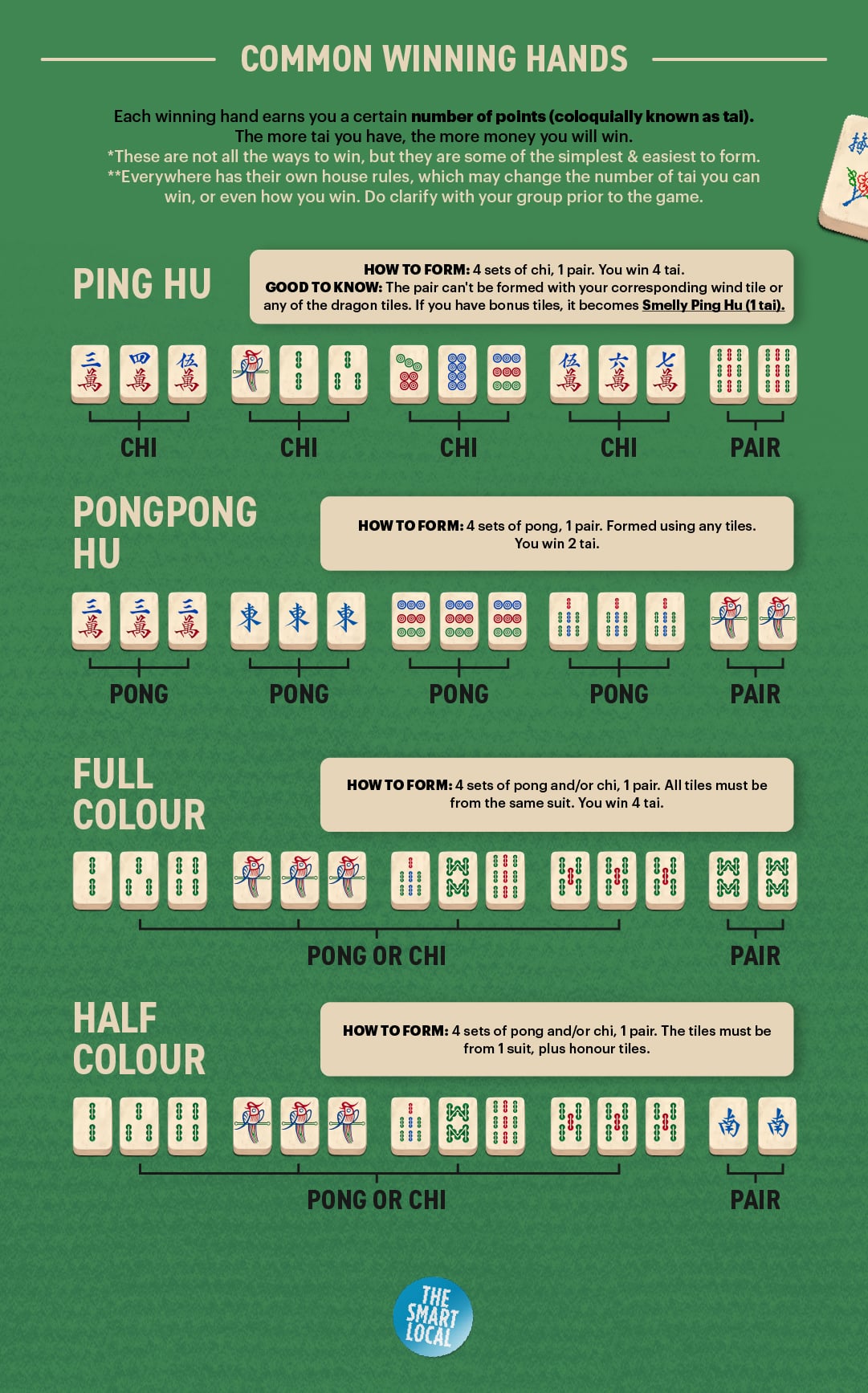
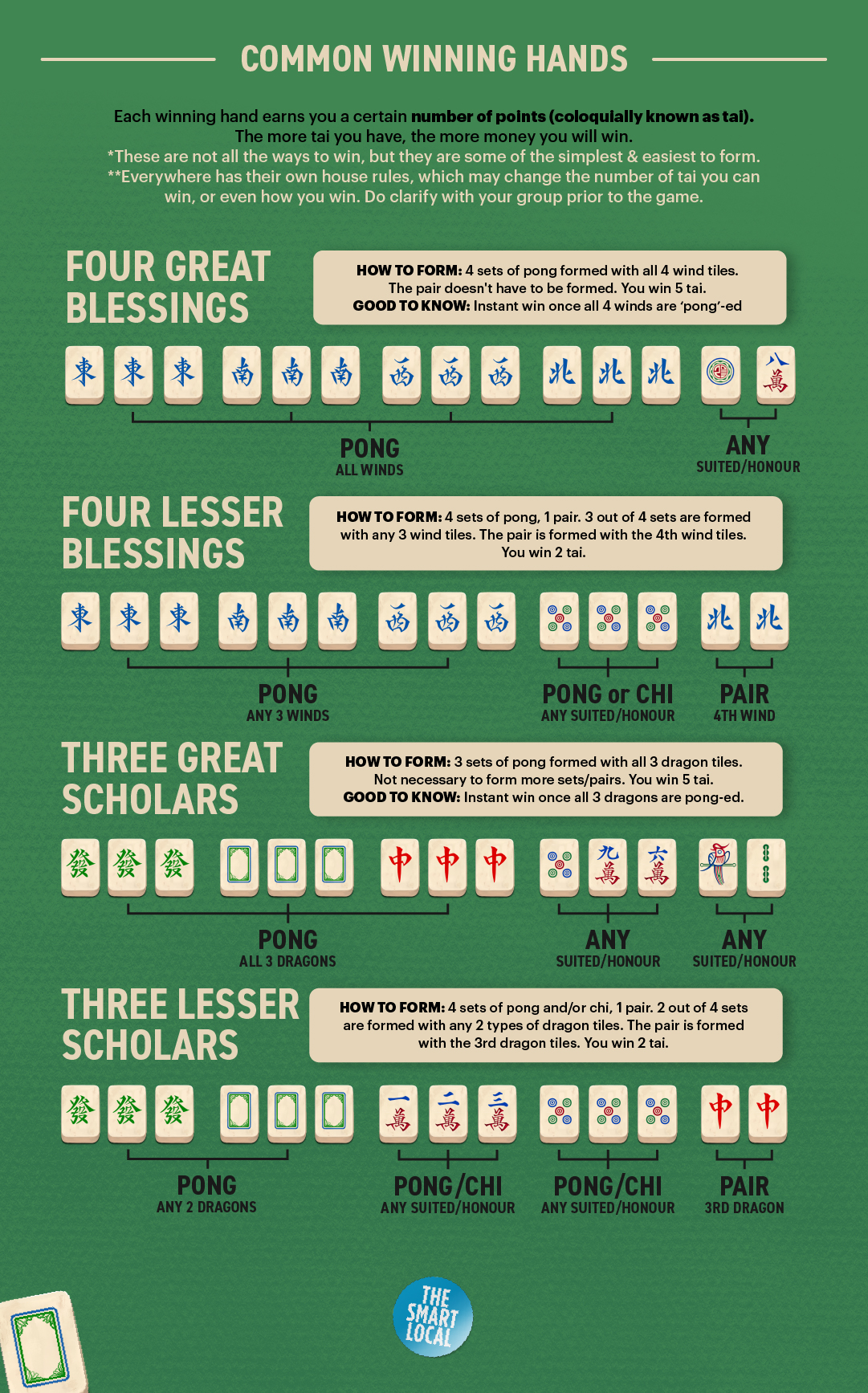
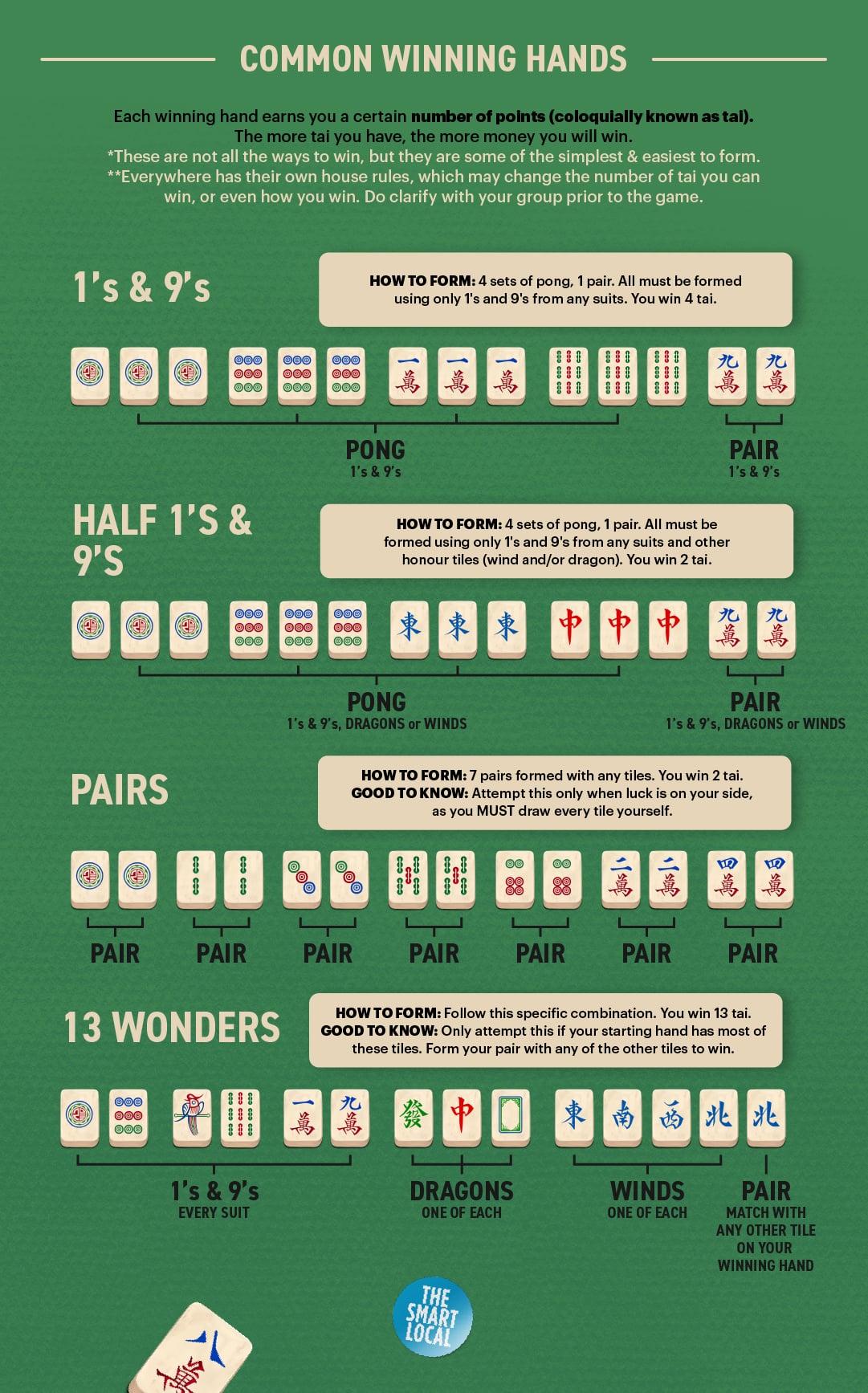
What are the various ways to earn more money & tais?
Earn instant money
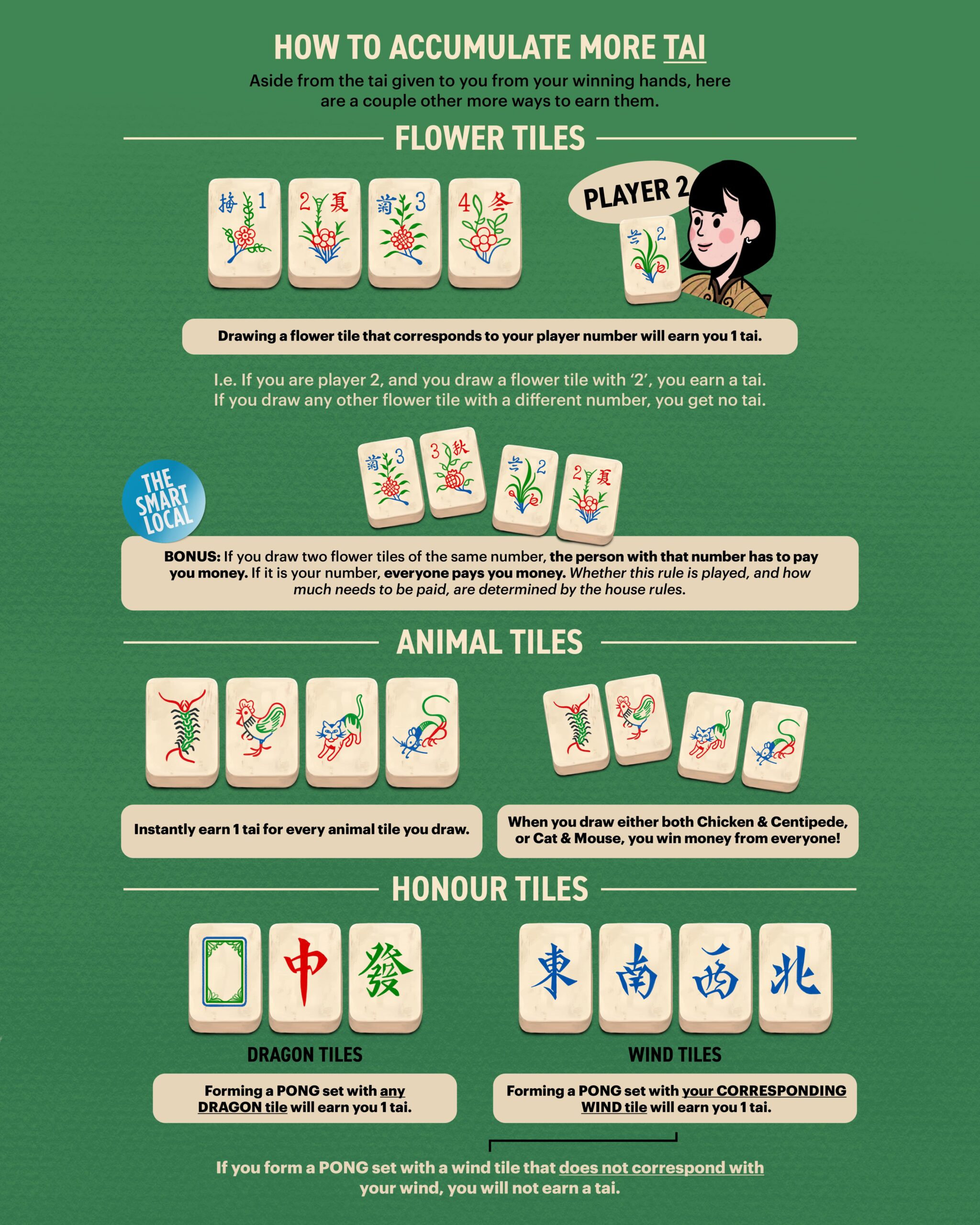
Winning a round isn’t the only way to earn cash. There are ways in which you can pocket a couple of bucks during the game. For one, you’ll get paid instantly when you gang. Here are other ways you can collect moolah immediately:
- When you draw both of your allocated Flower tiles.
- When you complete a set of 2 Flower tiles. You also get an extra tai for each completed Flower tile set.
- When you draw a pair of the Animal tiles – the Cat and Rat; or the Rooster and Centipede (‘cause you know, predator and prey). You also get an extra tai if you draw all 4 Animal tiles.
Increase the number of tais
Besides collecting Animal tiles and your corresponding Flower tiles, you can also accumulate more tais to increase your winnings. Here are some methods you can use to boost the number of tais you have:
- When you pong any of the Dragon tiles.
- Zi Muo – when your final winning tile is self-drawn from the common rows, and not taken from your opponent’s discarded tile.
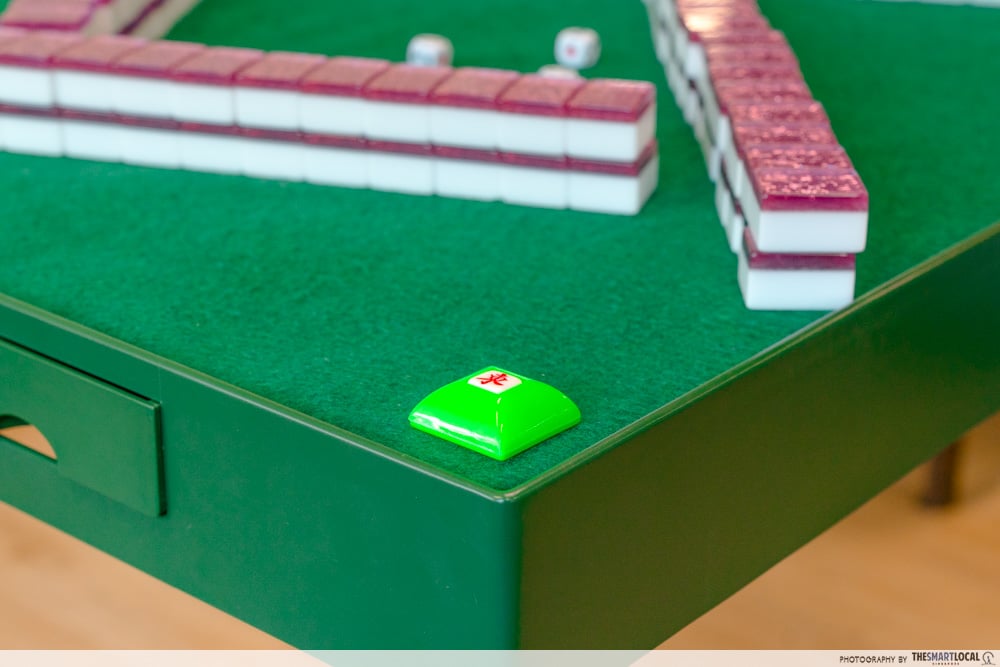
You’ll also get 1 tai if you pong the shared Wind.
- When you pong your corresponding Wind tiles.
- Men Qing – when you did not take any players’ discarded tiles throughout the whole game. Your final winning tile must also be self-drawn from the common rows.
How to calculate each game’s payout?
So you’ve finally won a round – good job! Or, you might’ve shot the winning tile for your friend. Regardless, it’s time to O$P$. While there are many payment systems you can adopt, the most common ones would be the 30¢/60¢ or the $1/$2 practice.
There are also 2 types of house rules when it comes to payment – colloquially known as “Shooter pay” or “Everyone pays”. The former means only the person who shot the winning tile will pay. For the latter, all 3 players are required to pay, and the person who gave the winning tile will pay more.
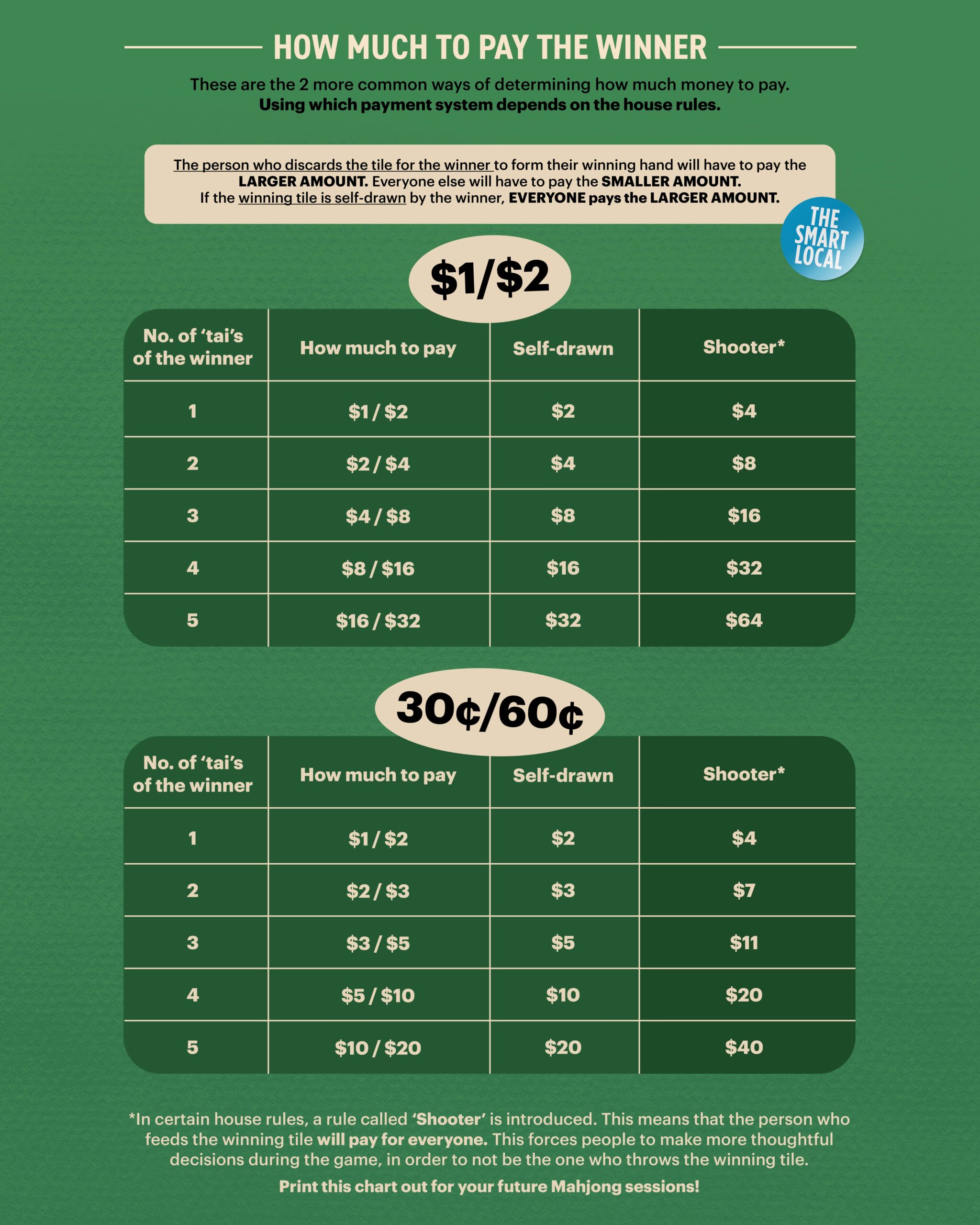
Tips from avid mahjong players
Much like every game, mastering the art of mahjong takes time and practice. After playing regularly, you’ll start to form your preferred methods and the best way to triumph over your opponents. To help speed up the process, we’ve compiled several tried-and-tested tips from long-time mahjong players for your consideration:
- If you want to go for Ping Hu, weigh out the odds by checking how many Flower tiles have appeared on the table. If there are very few, it means that there is a high chance you will kena a Flower tile. While Flower tiles aren’t necessarily bad, it does reduce your hand to a Smelly Ping Hu – which has fewer tais.
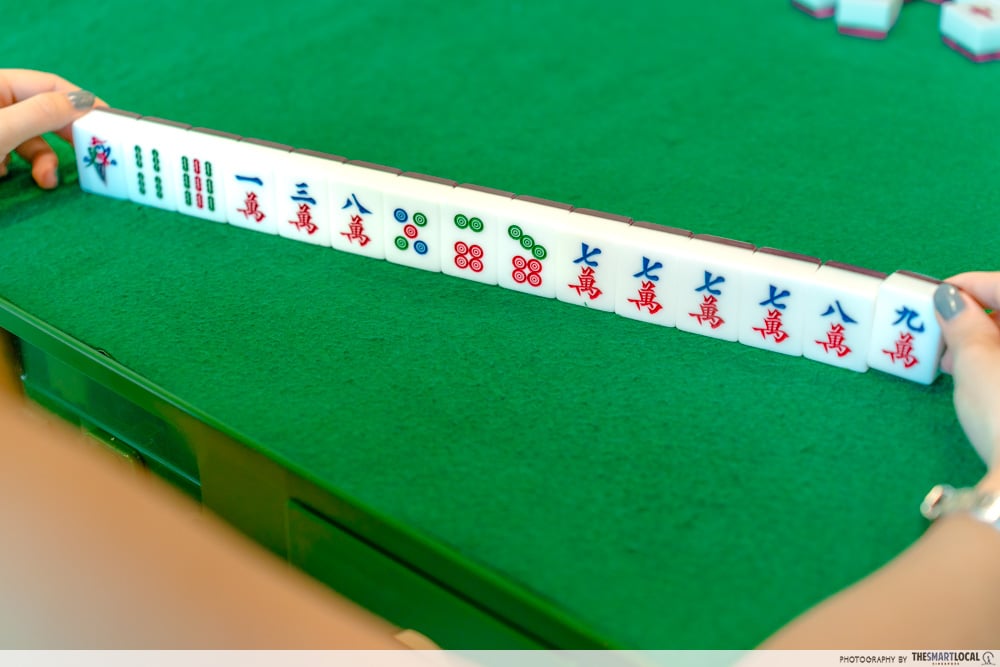
If you choose to gang 7 Characters, then you won’t have any more to complete your 8 and 9 Character tile set.
- For Circle, Bamboo, and Character suits, take a moment to consider before you gang, as sometimes keeping the 4th tile will help to build your chi sets.
- If you’re desperate to earn quick cash, prioritise retaining your dealership when it’s your turn – go for 1 tai instead of building up to 5 tais because you can keep enjoying the advantages of a dealer.

- During gameplay, rearrange your tiles occasionally so you can experiment with different combinations and choose the one that maximises your winnings.
Huat big & slay your mahjong kakis

There you have it – the survival guide to mahjong, and to CNY. And while there are various versions of mahjong, this one covers the Singapore Mahjong styles and rules, which can differ from the other variations. So before you start any game, remember to clarify with your opponents on their style of playing.
And yes, we know – mahjong can seem daunting at first. If it helps, there are also other resources you can use, including Facebook groups and Telegram channels like The Mahjong Diary that have open-ended discussions about more complex Singapore mahjong rules and other playing styles. Time to impress your ah gong and ah ma this CNY.
@thesmartlocalsg Send this to your friend who refuses to learn Mahjong 🀄️🀄️ Click the link in bio for a more comprehensive guide to playing Mahjong! Huat ah! #TSLHowTo #TSLGuides #mahjong #huat
More games for you and the gang to enjoy:
Photography by Afiqah Amir.
A portion of this content may contain referral links where The Smart Local may collect a commission. Our opinions remain our own.
Last updated by Nathan Koh on 11th December 2025.
